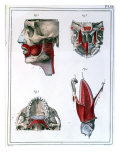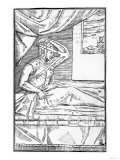|
|
Sense of Smell, Olfaction & Nose Anatomy Posters & Charts
for the science classroom and home schoolers, physicians and health professionals offices.
|
science > biology > anatomy > SENSE OF SMELL & NOSE < health
|
|
Olfaction is the detection of chemicals dissolved in the air. Pleasing odors, or smells, are described as fragrant, unpleasant smells are called stench.
|
|
Smell Poster
On average the human brain can detect between 2000 and 4000 different smells. Someone with a highly developed sense of smell can recognize as many as 10,000 odors. The sense of smell “wears off” more quickly than any other sense. The brain becomes accustomed to the new smell, and usually stops registering it within 30 seconds after is it first detected.
One the roof of each nasal cavity is a thumbnail-size patch of lining called the olfactory epithelium.
The olfactory epithelium consists of millions of olfactory sensory cells. Each of these cells has tiny hairs (cilia) projecting downward into a layer of mucus produced by Bowman's glands.
Odor molecules are dissolved in the mucus, which stimulates receptor sites on the cilia. This generates nerve signals that move upward through the nerve fibers to the olfactory bulb, where they are sorted before being sent to the brain for interpretation.
The sense of smell is strongest at birth, and diminishes as we age.
• respiratory system posters
|
|
|
|
Overview of Five Senses
One thing all senses share is that when they detect something, they translate it into a common form–the nerve signal, which travels along sensory nerves to the brain. These nerve messages are the body's “language.” Sense organs transform stimuli (such as sound waves, light rays, flavors, odors, or physical contact) into electrical nerve signals, which are instantly flashed to the brain for interpretation and identification.
• Sight • Hearing • Taste • Smell • Touch
|
|
|
|
Anatomy of the Throat and Jaw, from "Manuel D'Anatomie Descriptive Du Corps Humain"
• more Middle Ages posters
|
|
|
|
Ear, Nose & Throat Chart
Shows general anatomy including the middle and inner ear, septum of nose, lateral wall of nose, and inspiration, phonation, and posterior view of the larynx.
|
|
|
|
Reconstructive Surgery on the Nose, Illustration from 'De Curtorum Chirurgia Per Insitionem'
• more Middle Ages posters
|
|
previous page | top
|
|
I have searched the web for visual, text, and manipulative curriculum support materials - teaching posters, art prints, maps, charts, calendars, books and educational toys featuring famous people, places and events - to help teachers optimize their valuable time and budget.
Browsing the subject areas at NetPosterWorks.com is a learning experience where educators can plan context rich environments while comparing prices, special discounts, framing options and shipping from educational resources.
Thank you for starting your search for inspirational, motivational, and educational posters and learning materials at NetPosterWorks.com. If you need help please contact us.
|
|
|









